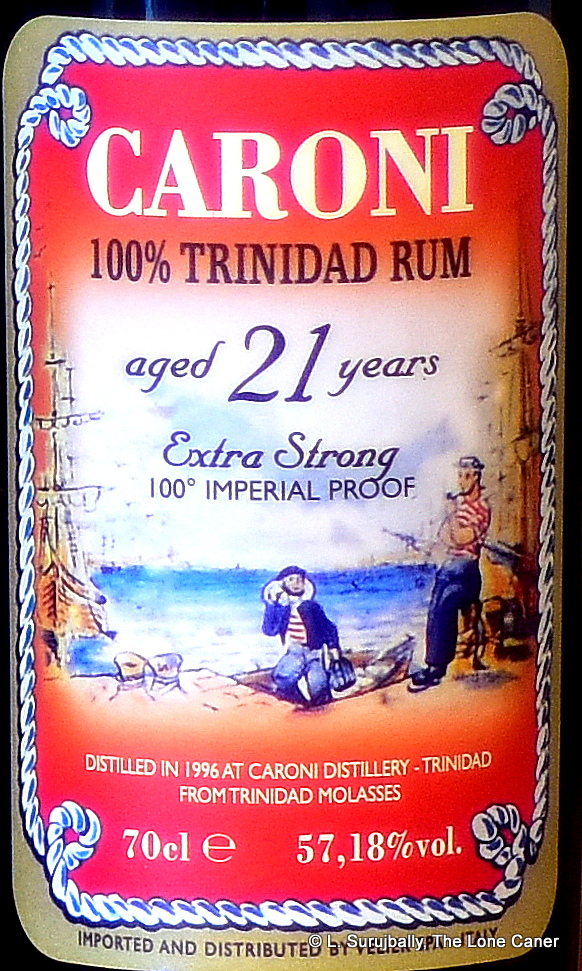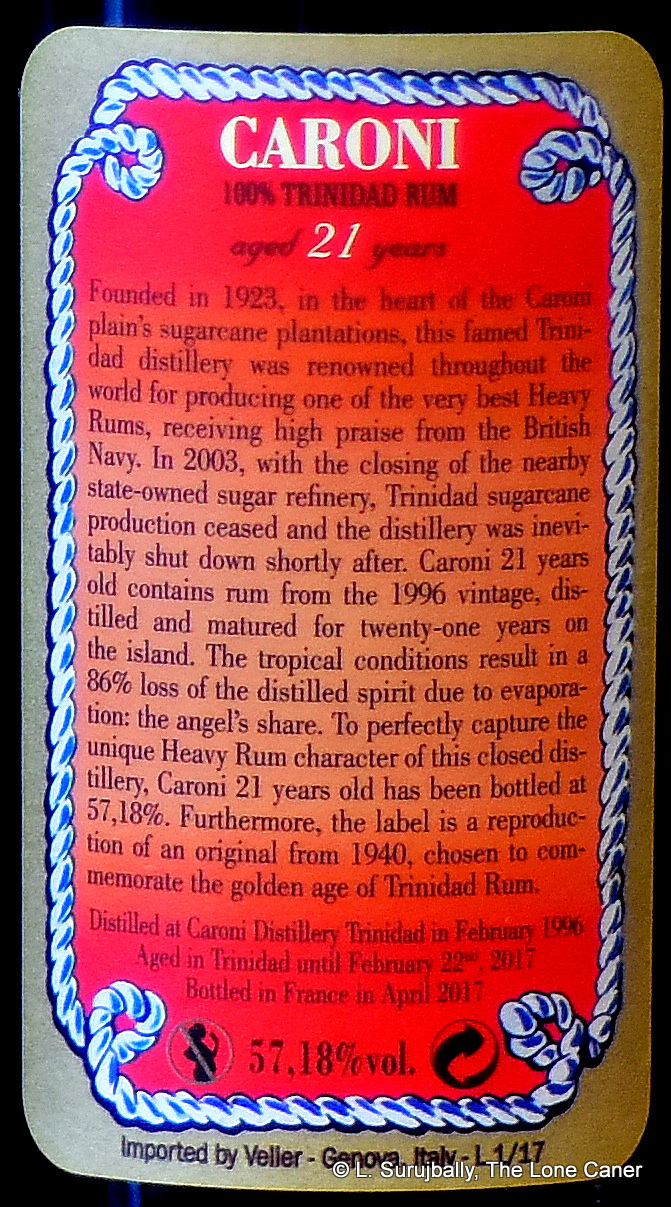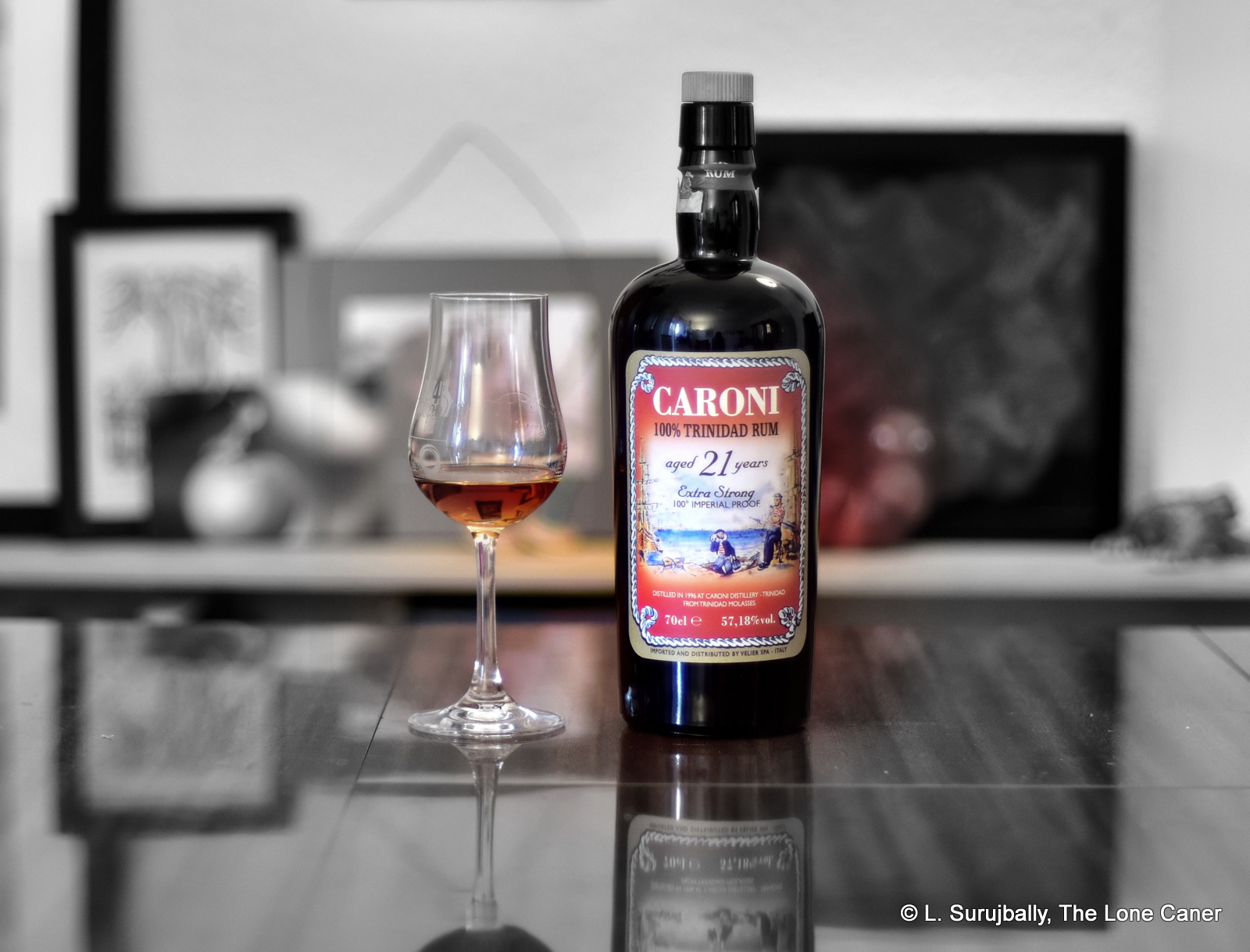By now, the story has entered into the folklore of rum: in October 2004 Luca Gargano and the (late) photographer Fredi Marcarini, sniffing out rums from around the Caribbean to round out Velier’s rum portfolio and being dissatisfied with Angostura’s offerings, decided to visit the Caroni distillery, even though it had already been closed for a year. Arriving at the premises and being let in, they were shown a warehouse where several thousand barrels dating back more than twenty years had been stored (and implied to be overlooked, if not actually forgotten). Most of the barrels were bought by Velier in several tranches over the following years, and always presented as some sort of exotic treasure, an undiscovered, unappreciated and unheralded jewel in the mud brought to light through intrepid and personal Indiana-Jones-style sleuthing that reaped the benefits — which larger and less adventurous rum bottlers who safely bought from European brokers, could and did not.
In the ensuing years beginning in 2005, Caroni rums were carefully released in limited batches to the market, primarily Italy. Just as with the Demeraras, these releases broke new ground – for one, the barrels were not always blended into huge consistent outturns of several thousand bottles, but were often released as they were, a few hundred at a time: at best maybe two or three barrels of similar provenance or age or strength might be combined. And this is why there are so very many Velier Caroni rums in existence – at last count I have about sixty-plus (the Hampden “Endemic Birds” series follows the principle of multiple bottle releases, though I submit it is for completely different reasons). Sometimes there are bottles from the same year, the same age, but a few proof points apart; in others, it’s a “Heavy” or a “Light” edition. Blends began to be issued in larger quantities.
 The rum from today is from the middle of the Caroni era (which we are still living through, even if the end may now be in sight) – distilled in 1996, blended and bottled in 2017 at “Imperial” proof of 100º (57.18%), a massive angel’s share of some 86%, resulting in an an outturn of about 7,000 bottles. The decision to bottle at this strength is supposedly to showcase the heavy character of the rum and perhaps genuflect to the Navy tradition, but I suspect this is more a convenience than anything else, as various lesser and greater proofs have always characterized the Caroni line without any such romantic explanations. The red and white label, it should be noted, like the gold-white-blue Tate & Lyle facsimile adorning some of Velier’s later Caroni editions, is a replica of the style of a 1940s original. Tracking that down proved elusive, unfortunately.
The rum from today is from the middle of the Caroni era (which we are still living through, even if the end may now be in sight) – distilled in 1996, blended and bottled in 2017 at “Imperial” proof of 100º (57.18%), a massive angel’s share of some 86%, resulting in an an outturn of about 7,000 bottles. The decision to bottle at this strength is supposedly to showcase the heavy character of the rum and perhaps genuflect to the Navy tradition, but I suspect this is more a convenience than anything else, as various lesser and greater proofs have always characterized the Caroni line without any such romantic explanations. The red and white label, it should be noted, like the gold-white-blue Tate & Lyle facsimile adorning some of Velier’s later Caroni editions, is a replica of the style of a 1940s original. Tracking that down proved elusive, unfortunately.
So, to the tasting then. By now the heavy, tarry and fusel-oil profile of the Caronis is one of the most recognized taste markers in the rum world, so it comes as no surprise to find it here: the rum presents opening aromas of rich caramel and tar, deeply intense, with petrol held way back. There’s licorice and dark fruits – raisins, prunes, plums and blackberries – plus a nice sharpish and lighter cognac kick that is far from unpleasant. The real characteristic of the nose seems to be less the diesel machinery than the garden, however – black grapes, very soft mangoes and all manner of overripe fruit. There’s just little tartness to balance that off…unsweetened yoghurt, maybe.
Tasting the thing reveals powerful tar and petrol notes by the bucketload, dry, oily and amazingly mouth coating. The profile is nicely solid, hardly sharp at all, and displays a touch of brine and olives, as well as — initially — an oddly metallic, medicinal sort of taste.

Once it settles down a richly dark, perfumed profile emerges for real: licorice, tar, dates, raisins, prunes, dark unsweetened chocolate, black grapes, blueberries, that cognac line again. There’s a delicate sort of citrus background that lends a nice counterpoint to the duskier, heavier tastes. It’s not a rum to hurry through, even on the finish: this is dry, long, aromatic, phenolic, leaving behind mostly sweet thick caramel molasses notes and some burnt rubber, plus a last flirt of exhaust fumes as it roars away into memory.
As a blend, it’s really kind of spectacular – there aren’t many of these deep, surly rums around any longer, and even the New Jamaicans’ high ester rums tend towards the fruity and sharp notes, not the brutal stomp-it strength of the Clydesdales that are the Caronis. That said, not everyone will like the heaviness of the experience: agricole lovers or those who prefer soft Spanish light rums will find little to enthuse them here, and that’s Caroni for you — not everyone is in tune with the steampunk esthetic and industrial farting of this long shuttered Trini style.
But I like it, and think that even if the prices of the smaller, older and rarer editions of Velier’s Caronis are too high, there’s still good quality and interesting tastes to be found in the high-outturn blends like 12 year old, or the 15, 17 and a few others. The appeal of the Caroni line of rums lies in their miniscule variations from one batch to the next (no matter who issues it), which allows any curious enthusiast to sample just a few and get a good sense for what it’s all about. The 21 year old from 1996 is among the oldest of these blends, and while it does cost a bit, it is, in my opinion, also among the best.
(#848)(86/100)
Other Notes
- It is often believed that Velier first released the Classic Demerara rums, and as their availability declined and the price ascended (sometimes beyond all reason), the Caronis came in to supplant them as the second great series of rums which made Velier’s reputation. But strictly speaking, this is not true – the awareness of the Caronis peaked much later, but they began to be released in 2005, just around the same time as the first “true” dark-bottled Demeraras from the Age began to hit the market.
Additional Background
The myth of the “discovery” of these thousands of barrels may be true, but others dispute it, claiming that it had always been known that the rum stocks were there and they existed and were for sale. This goes as far back as 2000 when the distillery was already in perilous financial straits and courting buyers, and one local story held that a foreign consultant valued the year 2000 existing stocks of eighteen thousand barrels at between TT$1 billion (about US$160,000) and TT$6 billion (~US$935,000) depending on whether they were sold as aged or bulk rums. Both numbers were seen as implausibly low (US$935,000 for 18,000 barrels works out to US$52/barrel), as the writer was at pains to point out.
The distillery shuttered in 2003, and as is now well known, independents like Velier et al, and Scheer/Main Rum, bought out the stocks over the next few years – it was not done all at once, nor was it only Velier, and it went through Government officers (one could hardly get an export license without them). What is missing from all accounts is the pricing asked for and paid, and for what volume. In 2018, by which time Caronimania was a well established (if misunderstood) phenomenon, Raffique Shah (the author of the original 2000 article) returned to the theme and scolded the politicians of the day for ignoring or not even understanding the rum stocks’ pricing given their elevation to the “Blue Label Crowd.” He suggested that they disdained their own country’s rum, couldn’t be bothered to do any due diligence, and allowed a huge potential windfall to slip through their fingers. He all but accused them of skullduggery and corruption.
Whether any of this is true or not is, at this remove, probably impossible to tell. Commercial entities are under no obligation to disclose such matters and since we know neither the volume of barrels sold nor the amount paid for each, or by whom, anything beyond this point is just uninformed speculation that hopefully will one day be replaced by facts. But it’s a good case study in how rums (or any local third world resources for that matter) get bought and sold.
